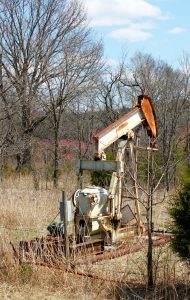Oklahoma Bar Journal
Overcoming Oklahoma’s Orphaned and Abandoned Well Problem
By Niles Stuck

Susan Vineyard | #183993500 | stock.adobe.com
Oil and gas-producing states, including Oklahoma, are dotted with abandoned wells that risk the health and safety of those who live and work near them. Oklahoma Statutes create a regulatory framework intended to balance the interests of oil and gas operators who manage marginal wells with the public’s interest in ensuring those wells do not pollute the environment and are ultimately plugged. The Oklahoma Corporation Commission (the Commission) is tasked with enforcing these 30-year-old laws, but as we will see in the case study below, their ability to prevent the abandonment of wells is limited by statute. While Oklahoma law has struggled to discourage operators from abandoning wells, new and inventive efforts to plug these abandoned wells have been promoted both in legislation and at the Commission.[1]
There are 16,978 wells listed on the “Orphan Well List” available from the Oklahoma Corporation Commission.[2] These are wells that have been managed by operators, but those operators have either ceased to exist or the Commission has ordered their surety forfeited. Oklahoma law provides:
The Corporation Commission is hereby authorized to promulgate rules for the plugging of all abandoned oil and gas wells. Abandoned wells shall be plugged under the direction and supervision of Commission employees as may be prescribed by the Commission. Provided, however, the Commission shall not order any oil or gas well to be plugged or closed if the well is located on an otherwise producing oil or gas lease as defined by the Commission, unless such well poses an imminent threat to the public health and safety which shall be determined by the Commission after conducting a public hearing on the matter.[3]
Statute further requires all operators to post a $25,000 Category B surety that is intended to ensure funds are available to satisfy plugging costs.[4] The Commission is authorized to augment the surety solely upon demonstrating good cause concerning pollution or improper plugging, following an application initiated by the director of the Oil and Gas Conservation Division and subsequent to notice and hearing.[5] Category B sureties are capped at $100,000.[6] In the event a well poses the risk of pollution and the responsible operator cannot be found or is financially unable to pay for plugging, the Commission may plug that well using its plugging fund.[7]
As a practical matter, the plugging liability of most operators is greater than $25,000. The Commission’s threat to force an operator to remediate pollution and plug a well or have their surety revoked is hollow if the operator can avoid the plugging by agreeing to forfeit a surety that is less than the plugging liability. It makes economic sense to forfeit a surety if the cost of compliance is more expensive. The operator will lose the ability to operate wells in Oklahoma, but that is only an incentive so long as the value of the wells they own is greater than their plugging liability. Once the operator has been found to be out of compliance with Commission regulations, the Commission can raise the operator’s surety; however, in many instances, the operator has already chosen to abandon their wells. Once an operator puts themselves in this position, there is no reason for them to pay any additional surety. While raising a surety decreases the likelihood an operator may plug their wells, the Commission has few other options to encourage responsible operation. If the Commission does not raise the surety, an operator would repeatedly abandon specific wells with a plugging liability greater than $25,000. An increased surety prevents a bad actor from continuing to operate oil and gas wells but also incentivizes those bad actors to abandon wells.
ILLUSTRATION
The best way to illustrate this regulatory scheme regarding orphaned wells in Oklahoma is to review an actual case. For illustration purposes, we will review SF 2023-000001, the first application filed in 2023 in which the Commission sought to use public funds to plug a well filed on Jan. 4. The well at issue was the Smith No. 1 Well in Section 19, Township 7 North, Range 4 West, McClain County, Oklahoma. There was nothing unusual or special about this well or the application to plug it. It was chosen because it was the first well the Commission sought to plug last year.
Jones & Pellow Oil Co. drilled the Smith well in 1965. It was bought and sold a few times until it was ultimately purchased by Southcreek Petroleum Co., officing in Blanchard in 1995. There is nothing in the Commission’s records to suggest the Smith well was a problem between 1965 and 2023, but Southcreek operated another well, the Peters #1-28 Well in Section 28, Township 4 North, Range 1 West, Garvin County, Oklahoma.
The Peters well was drilled in 1969, but production ceased in 2009. On Nov. 12, 2020, Robyn Strickland, director of the Oil and Gas Conservation Division, filed a complaint for contempt of rules and regulations, claiming that Southcreek had failed to remove materials that might constitute a fire hazard, failed to post proper lease signs and failed to plug the well properly. The Commission sought to raise or revoke Southcreek’s surety and assess fines.

Alexandr | #315324209 | stock.adobe.com
On Dec. 30, 2020, a hearing was held before an administrative law judge where a Commission field inspector testified that Southcreek had stopped mowing around the well and had not posted proper signs. He testified that he complained to Southcreek in May 2019, but the operator had not taken any action. The field inspector also testified there was a hole in the production casing, and the well posed a risk of water pollution. Southcreek’s managing partner testified they were experiencing financial difficulties and could not afford to maintain their wells.
Ultimately, the Commission ordered Southcreek’s surety to be forfeited and used to plug the Peters well. It also required Southcreek to post a new $100,000 surety before it could operate any wells in Oklahoma. While Southcreek forfeited its $25,000 surety, the field inspector testified it would cost approximately $28,000 to plug the Peters well. In addition to the Peters well, Southcreek operated 29 other wells, including the Smith well. Southcreek did pay a $1,000 fine but did not pay the increased surety, and those 29 wells became abandoned or “orphaned.” The Peters well was plugged in 2022.
By 2023, the Smith well had become a problem. On Jan. 4, Director Strickland filed an application requesting an emergency order to plug it. On Jan. 13, a field inspector testified the well was surrounded by pollution and threatened the surrounding cattle and water. The well site was so polluted the inspector could not gain access to the wellhead to determine pressure. The inspector estimated the cost of plugging the well would be $48,200. The Smith well was plugged using state funds pursuant to an emergency order on July 18, 2023, but by then, the cost of plugging had ballooned to $70,852. The original order increasing Southcreek’s surety references 28 other wells in addition to the Peters and the Smith wells, six of which remain on the orphaned well list waiting to be plugged at taxpayers’ expense.
EFFORTS TO ADDRESS ORPHANED OIL AND GAS WELLS
As we have seen, the Commission may increase surety to discourage operators from operating wells that risk pollution, but the Commission is limited by statute to only address this issue after operators fall out of compliance. Absent a hearing and order determining that an operator has caused pollution or refused to properly plug wells, the Commission may not increase its surety beyond $25,000.[8] Notably, the Commission cannot consider an operator’s plugging liability when requesting an increase in surety absent an order addressing pollution or plugging. In other words, an operator may acquire an unlimited number of marginal wells and the associated plugging liability, and the Commission is prohibited by statute from increasing their surety until they cause pollution or refuse to plug wells. By the time an event occurs that would result in increased surety, plugging liability may very well be greater than the maximum $100,000 surety, and the operator is incentivized to abandon those wells rather than pay the increased surety, fines and cost of plugging. Statute does allow the Commission to consider total plugging liability but only upon an application brought by an operator to reduce their bond upon a determination that their plugging liability is less than $25,000.
Efforts to address the surety scheme and use it to encourage responsible operation of oil and gas wells have stalled, but more success has been made in efforts to plug and remediate wells after they have been orphaned.
The $25,000 Category B surety requirement scheme dates back to June 7, 1989. In 2022, Sen. Zack Taylor and Rep. Brad Boles introduced legislation to increase surety requirements to as much as $150,000 for operators with more than 200 wells. That legislation died in the House Energy and Natural Resources Committee.
On Nov. 15, 2021, the Infrastructure Investment and Jobs Act (IIJA) was passed, providing federal funds to plug abandoned and orphaned wells. As a result, the Commission received $25 million to begin plugging in 2022. After an initial delay to ensure compliance with the program, the Commission began plugging abandoned wells in April 2023. In the 2023 fiscal year ending on June 30, the Commission contracted to plug 106 abandoned wells using federal funds. The first four of those wells were plugged at an average cost of $20,125. At that average cost, the first payment of federal funds can plug 1,242 orphaned wells. An additional $560 million is available from the IIJA, divided amongst various states. The U.S. Department of the Interior estimates Oklahoma’s share of that money to be as high as $281 million. Wells plugged pursuant to the IIJA include requirements, such as methane testing, that are not required by the state-funded plugging program. In fiscal year 2023, the state program resulted in the plugging of 376 wells at an average cost of $17,861.[9]
Oklahoma has most recently attempted to use carbon offset credits to incentivize the plugging of abandoned or orphaned wells. A carbon offset credit, in this context, can become available when a party that is not otherwise liable to plug a well does so and prevents a measurable amount of harmful gas, usually methane, from being released into the atmosphere. Such a credit becomes profitable when another party purchases it to offset its carbon footprint.
In 2023, Gov. Stitt signed SB 852 into law. Authored by Sen. Dave Rader and Rep. Brad Boles, this bill amended 52 O.S. §310 to allow the Commission to establish a framework by which carbon offset credits can be created by plugging abandoned wells. The law allows the Commission itself to obtain these credits and use funds generated from their sale to pay for additional funding. The Commission may also establish a method by which it can transfer these wells and the associated credits to a third party.[10] While these Commission rules are being negotiated, many companies and nonprofits have expressed interest in participating in this emerging marketplace.[11]
CONCLUSION
The Oklahoma Corporation Commission is tasked with regulating the operation of wells in a manner that both discourages their abandonment and ensures abandoned wells are properly plugged. Oklahoma Statutes limit the Commission’s authority to use surety requirements to discourage abandonment, but recently, legislative action at both the state and federal levels has provided new and creative incentives intended to ensure that such wells are properly plugged and public safety preserved.
 ABOUT THE AUTHOR
ABOUT THE AUTHOR
Niles Stuck is a 2008 graduate of the OU College of Law who practices energy regulation law at A New Energy LLC and previously served as an administrative law judge at the Oklahoma Corporation Commission. Since leaving the Commission, he developed a practice at both the Commission and in district court. When not practicing law, Mr. Stuck enjoys time with his wife and two children in Edmond.
ENDNOTES
[1] I would like to thank my colleagues at A New Energy LLC, especially attorneys Jim Roth and Lindsey Pever and intern Chris Contreras. Their advice and edits have been invaluable.
[2] https://bit.ly/3PFiEwW.
[3] 17 O.S. §53.
[4] 52 O.S. §318.1(A)(2).
[5] 52 O.S. §318.1(C).
[6] Id.
[7] 52 O.S. §52.
[8] 52 O.S. §318.1(C).
[9] Mike W. Ray, “Federal well-plugging program now underway in Oklahoma,” Southwest Ledger News, June 13, 2023. https://bit.ly/3x9oUqn.
[10] 52 O.S. §310(B).
[11] The Orphan Well Management Association, which my firm and I represent, has been created as a 501(c)(6) trade association to promote the interest of these participants.
Originally published in the Oklahoma Bar Journal – OBJ 95 No. 5 (May 2024)
Statements or opinions expressed in the Oklahoma Bar Journal are those of the authors and do not necessarily reflect those of the Oklahoma Bar Association, its officers, Board of Governors, Board of Editors or staff.
